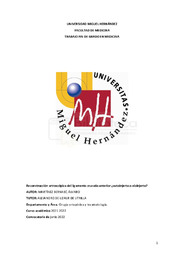Please use this identifier to cite or link to this item:
https://hdl.handle.net/11000/28848Full metadata record
| DC Field | Value | Language |
|---|---|---|
| dc.contributor.advisor | Lizaur-Utrilla, Alejandro | - |
| dc.contributor.author | Martínez Bernabé, Álvaro | - |
| dc.contributor.other | Departamentos de la UMH::Patología y Cirugía | es_ES |
| dc.date.accessioned | 2023-01-31T12:35:18Z | - |
| dc.date.available | 2023-01-31T12:35:18Z | - |
| dc.date.created | 2022-05-25 | - |
| dc.identifier.uri | https://hdl.handle.net/11000/28848 | - |
| dc.description.abstract | Objetivo: comparar el resultado clínico del autoinjerto de isquiotibiales frente a procedimientos con aloinjertos en una reconstrucción de LCA mediante artroscopia. Material y métodos: se ha llevado a cabo una búsqueda en diferentes bases de datos y hemos seleccionado 7 estudios prospectivos, 5 comparativos randomizados y 2 no randomizados, en todos ellos se comparaba un grupo de autoinjerto de isquiotibiales con un grupo de aloinjerto de uno o varios tipos. Para medir el resultado funcional, se ha utilizado una serie de escalas subjetivas (Lysholm,Tegner, IKDC) y una medición de laxitud objetiva (Artrómetro KT-2000). Resultados: Se dividieron los resultados en función del tipo de aloinjerto que se comparaba con el grupo de autoinjerto de isquiotibiales. Todos los estudios coincidieron en que no se encontraron diferencias significativas entre ambos grupos según las escalas subjetivas. Sin embargo, también se ha objetivado una mayor laxitud en el grupo de aloinjerto en todos los grupos del mismo, menos en el de hueso-patela-hueso. Conlcusión: se ha objetivado una similitud entre los resultados funcionales a corto plazo entre el grupo de autoinjerto y el grupo de aloinjerto. No obstante, el autoinjerto de isquiotibiales ha ofrecido mejor incorporación biológica y estabilidad de la rodilla. | es_ES |
| dc.description.abstract | Objective: To compare the clinical outcome of hamstring autograft versus allograft procedures in arthroscopic ACL reconstruction. Material and methods: a search has been carried out in different databases and we have selected 7 prospective studies, 5 randomized comparative and 2 non-randomized, in all of them a hamstring autograft group was compared with an allograft group of one or various types. To measure functional outcome, a series of subjective scales (Lysholm, Tegner, IKDC) and objective laxity measurement (KT-2000 arthrometer) have been used. Results: The results were divided according to the type of allograft that was compared to the hamstring autograft group. All the studies agreed that no significant differences were found between the two groups according to the subjective scales. However, greater laxity has also been observed in the allograft group in all groups, except in the bone-patella-bone group. Conclusion: a similarity between the short-term functional results between the autograft group and the allograft group has been observed. However, the hamstring autograft has offered better biological incorporation and stability of the knee. | es_ES |
| dc.format | application/pdf | es_ES |
| dc.format.extent | 22 | es_ES |
| dc.language.iso | spa | es_ES |
| dc.publisher | Universidad Miguel Hernández de Elche | es_ES |
| dc.rights | info:eu-repo/semantics/openAccess | es_ES |
| dc.rights.uri | http://creativecommons.org/licenses/by-nc-nd/4.0/ | * |
| dc.subject | LCA | es_ES |
| dc.subject | Autoinjerto | es_ES |
| dc.subject | Aloijerto | es_ES |
| dc.subject | Isquiotibiales | es_ES |
| dc.subject.other | CDU::6 - Ciencias aplicadas::61 - Medicina | es_ES |
| dc.title | Reconstrucción artroscópica del ligamento cruzado anterior ¿autoinjerto o aloinjerto? | es_ES |
| dc.type | info:eu-repo/semantics/bachelorThesis | es_ES |

View/Open:
MARTÍNEZ BERNABÉ, ALVARO,TFG.pdf
679,58 kB
Adobe PDF
Share:
.png)
